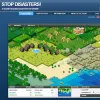Take a look inside 4 images
Stop Disasters!
Pros: This game's high entertainment value is matched with great learning potential.
Cons: The results can feel gloomy and aren’t appropriate for all ages.
Bottom Line: Few other browser-based sims better illustrate the potential of gaming for learning about serious issues in our world.
Make the game homework after a classroom discussion in whichever subject -- science, economics, global issues, and engineering -- you're using it to explore. For science and engineering, ask students to make notes after playing about a device or method they discovered through gameplay that helps guard against natural disasters. Use one that they choose for a longer investigation of how it works, pulling out real-life examples of where scientists and engineers used, for example, a seismic sensor that resulted in saving lives.
Consider pairing students and have them take turns while one plays and the other takes notes about changes in data or key choices that influenced the overall outcome. Where time allows, sims also offer a great opportunity to re-create the game offline -- think about presenting teams of students with a budget and a challenge when they arrive to class, and use similar game mechanics to have them compete to protect their school or community in the face of one of the game's scenarios.
Stop Disasters! is a serious sim game published by the United Nations and International Strategy for Disaster Reduction. No one should play it without first understanding that death and destruction -- outcomes of many natural disasters -- are also potential outcomes of the game, though at no point is it graphic or gory. Five potential environmental disaster scenarios are presented as typical sim game maps, which get larger and more complex depending on which of three (easy, medium, hard) game levels is chosen by the player. An on-screen docent presents the players’ challenge at the start of each round, which typically involves building shelter, defending resources like water towers, and developing land into infrastructure that yields added safety or contributes to the area’s economy. Each challenge has a limited budget, and players take on an omniscient role that feels part governmental policymaker and part chief engineer.
Maps are pre-populated and already have some infrastructure in place. Each map square reveals clickable options for defense, development, or more information, and players make choices about what to do with the land in order to achieve their challenge of sheltering citizens and using science and engineering to prepare the landscape for the worst-case scenario against wildfire, floods, earthquake, hurricane, or tsunami. Gameplay relies on close reading to glean facts and tips along the way that significantly improve chances for success. The audio and visuals of Stop Disasters! are a standout for a browser-based sim game of its kind.
Yes. As with good cooking, the ingredients that make Stop Disasters! a success are baked-in. Designers at Playerthree don’t skimp on sensory elements that make games playable -- good, crisp graphics and rich sound -- and that makes all the difference in how engaged and learning-ready players are. The issues aren’t specific to actual disasters (a plus for shelf-life, and a minor demerit for a hardcore realist), but they don’t feel diluted, either. At first glance, the challenges for each map seem straightforward, but players quickly realize that success is complex and requires close attention to details: How much does a given investment reduce risk? What’s the cost of a firebreak vs. nonflammable rooftops? How might building schools increase people’s ability to fend for themselves? The most important feature in this game is that players have the agency to investigate and experiment to find the answers themselves.
Available in five languages, the game presents interesting opportunities for language learners but might be tough without strong reading abilities, as the volume of text is fairly intense, even when playing on easy levels. The coolest part about Stop Disasters! is that each challenge is presented the way it is in life -- not subject-specific but situation-specific -- and, as a result, educators and learners gain a terrific opportunity to explore science, global issues, economics, and engineering all in the same place.












